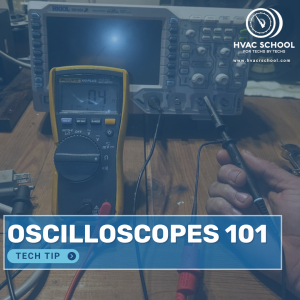BACK
 Brownouts and How They’re Killing HVAC Equipment
Brownouts and How They’re Killing HVAC Equipment
 CAT Ratings on Electrical Multimeters
CAT Ratings on Electrical Multimeters
 Refrigeration Communication Troubleshooting Using Oscilloscopes
Refrigeration Communication Troubleshooting Using Oscilloscopes
 What is RS-485 Communication?
What is RS-485 Communication?
 Oscilloscope Systems and Settings
Oscilloscope Systems and Settings
 Oscilloscopes 101
Oscilloscopes 101
 Estimating Made Easy with Unity Build
Estimating Made Easy with Unity Build
 Buck-Boost Transformers
Buck-Boost Transformers
 Switch Terms
Switch Terms
 Don’t Overfill Refrigerant Recovery Cylinders The Easy Way
Don’t Overfill Refrigerant Recovery Cylinders The Easy Way
 Something You May Want to Consider on Every Call
Something You May Want to Consider on Every Call
 Motor Tap Battle
Motor Tap Battle
 Split-Phase vs. 3-Phase – Short #253
Split-Phase vs. 3-Phase – Short #253
 Understanding Voltage Drop – Short #251
Understanding Voltage Drop – Short #251
 When 0V Isn’t Safe – Short #242
When 0V Isn’t Safe – Short #242
 Multiple Surge Protectors – Short #236
Multiple Surge Protectors – Short #236
 MCA is 27 and the Breaker is a 50A – Short #219
MCA is 27 and the Breaker is a 50A – Short #219
 Deploying Surge Protection & Voltage Monitoring w/ DITEK
Deploying Surge Protection & Voltage Monitoring w/ DITEK
 Surge Protection Basics w/ DITEK
Surge Protection Basics w/ DITEK
 What Is Up With Blower Amps & Watts w/ Steve Rogers
What Is Up With Blower Amps & Watts w/ Steve Rogers
 Residential & Rack Startup and Commissioning (Part 1)
Residential & Rack Startup and Commissioning (Part 1)
#electrical
Tech Tips:

HVAC technicians typically focus on diagnosing issues related to mechanical wear, refrigerant leaks, or control problems within the equipment. However, damage can also originate from external sources. For instance, a failed control board might be attributed to internal shorts or rubouts. Yet, the root cause could be external, such as the voltage spike that can […]
Read more

If you have a multimeter for HVAC work, you most likely have a meter with a CAT III rating on it. Some might also be rated for CAT II at higher voltages or CAT IV at lower ones—or both, like this model of the UEi DL599 from our Multimeter 101 for HVAC 3D video. In […]
Read more

This tech tip is the final installment in our short series on using oscilloscopes to troubleshoot communicating systems. This time, we're focusing on troubleshooting communication issues in commercial refrigeration systems. Imagine this scenario: you've got a refrigeration system acting up, and the comms network, whether it's LON or MOD-bus, seems a bit flaky. Let me […]
Read more

This tech tip about RS-485 communication is the third installment in a four-part series about oscilloscopes. It's a primer for the final installment about using an oscilloscope for diagnosis. I owe a special thanks to Jeremy Smith for sharing the information on Danfoss and for sparking my curiosity surrounding this type of communication. Let's talk […]
Read more

This is part two of our four-part series on oscilloscope fundamentals. Special thanks to Andrew Holden for his contributions. In our last tech tip on oscilloscopes, we learned about some safety basics, waveforms, and measurements. We’re going to dive a little deeper into systems and settings on the oscilloscope in this tech tip. Systems are […]
Read more

This tech tip is the first in a four-part series on using oscilloscopes. I'd like to give a special thanks to Andrew Holden for his contributions to this particular tech tip. When we want to measure voltage between two points, we reach for a multimeter. A multimeter can tell us the average electrical potential between […]
Read more

Many of you may already know that our HVAC company, Kalos Services, is also a GC. We do a lot of construction projects with HVAC, plumbing, and electrical scopes of work. Estimating is a crucial part of winning those projects, and those of you who work on HVAC for new construction probably already have an […]
Read more

HVAC systems often fail early or don't perform well due to inconsistent power. While technicians can't control a home's main power supply, they can stabilize it at the system using buck-boost transformers. These devices adjust voltage up or down to meet the equipment’s needs. As HVAC systems become more advanced, understanding buck-boost transformers will be […]
Read more

A while back, I had a tech who was having some trouble finding a 35 PSI (2.41 bar) make-on-fall pressure switch. One adjustable switch in the catalog said (SPDT), but he didn't quite understand what that meant. In that case, it means single-pole, double-throw, and the “double-throw” part means that the switch has terminals in both the […]
Read more
Videos:

In this video we review the HVAC School app tank fill calculator and how to use it to prevent the overfilling of refrigerant recovery cylinders.
Read more

There are a few important things that I suggest checking on every service call to reduce callbacks and increase customer satisfaction. One of them that often gets missed is preventing wire rub outs. One of my area managers and experienced tech Jesse Claerbout shot a video showing the simple step he takes to prevent major […]
Read more

In this video we cover Basic Motor Wiring Run, Common and Start legs Multi Speed motors and whether the speed taps are common, run or start The location of a thermal overload in a multi speed blower motor If you have an iPhone, subscribe to the podcast HERE, and if you have an Android phone, […]
Read more
Podcasts:

In this short podcast episode, Bryan breaks down the differences between split-phase and 3-phase power in HVAC systems. Split-phase is a form of single-phase power, and it's common in residential HVAC. Three-phase power is more common in commercial and industrial applications. Single-phase power uses only one of the three phases of power produced by the […]
Read more

In this short podcast episode, Bryan drops some knowledge to help with understanding voltage drop, a few different causes of it, and NEC recommendations. Voltage is electrical potential or “pressure,” and voltage drop is the reduction in electrical potential energy. We often think of it happening across conductors (which add resistance), but it also […]
Read more

In this short podcast episode, Bryan covers some unique electrical cases: when 0v isn't safe. When you measure voltage, you're finding out the electrical potential between two points. Just because there is 0v between one point and another doesn't mean there will be 0v between those points and other points. Non-contact voltage detectors are […]
Read more

In this short podcast episode, Bryan answers a listener-submitted question asking whether you can use another surge protector at the disconnect panel with an ICM 493 already in place. Using multiple surge protectors in the configuration described does NOT count as daisy-chaining. Surge protectors with MOVs (metal oxide varistors) shunt current from high voltage […]
Read more

In this short podcast episode, Bryan and Mike from DITEK talk about what to do in tricky electrical scenarios, such as when the MCA is 27 and you have a 50A breaker. When you size an HVAC system for compatibility with voltage monitors, like the DITEK Kool Guard, you need to pay attention to […]
Read more

Bryan discusses surge protection devices (SPDs) with Mike from DITEK, focusing on practical applications for HVAC contractors and how to provide value to clients. Mike emphasizes that surge protection is essential for modern HVAC systems, particularly given that they are typically the most expensive appliance in a home and increasingly rely on sophisticated electronic […]
Read more

In this enlightening episode, we sit down with Mike, a 20-year veteran from DITEK, a leading American manufacturer of surge protection devices based in Largo, Florida. The conversation begins with a brief discussion about recent hurricane impacts in the Tampa Bay area, where DITEK maintains its 65,000-square-foot manufacturing facility. Mike shares how the company, […]
Read more

Bryan Orr and Steve Rogers dive deep into measuring power consumption in HVAC blower motors, particularly focusing on the differences between PSC (Permanent Split Capacitor) and ECM (Electronically Commutated Motor) technologies. The discussion stems from a question raised at an educators' conference about the accuracy of clamp-on meters in measuring blower motor watt draw, […]
Read more

In this episode of the HVAC podcast, Bryan and Max Johnson from Kalos discuss the critical role of a startup and commissioning technician in the HVAC industry. Max, who has experience in both residential and commercial HVAC, shares his insights on the importance of understanding the scope of work, equipment specifications, and code requirements. […]
Read more











